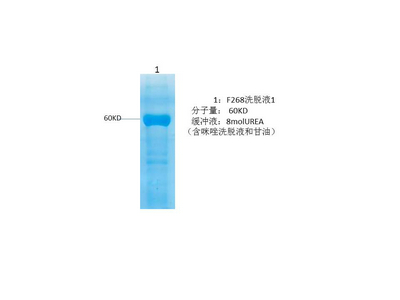- Home
- About
- Promotions
-
Products
-
Elisa Kits
- |
-
Primary antibodies
- |
-
Secondary antibodies
- |
-
Proteins
- |
-
IHC reagents
- |
-
WB reagents
- PonceauS Staining Solution
- PBST Washing Buffer, 10X
- 1.5M Tris-HCl Buffer, pH8.8
- 1M Tris-HCl Buffer, pH6.8
- 10% SDS Solution
- Prestained Protein Marker
- TBST Washing Buffer, 10X
- SDS PAGE Loading Buffer, 5X
- Stripping Buffered Solution
- Tris Buffer, pH7.4, 10X
- Total Protein Extraction Kit
- Running Buffer, 10X
- Transfer Buffer, 10X
- 30% Acr-Bis(29:1) Solution
- Tris电泳液速溶颗粒
- PBS(1X, premixed powder)
- TBS(1X, premixed powder)
- 快速封闭液
- 转膜液速溶颗粒
- Chemical reagents
- News
- Distributor
- Resources
- Contact
- Home
- >
- Info
- >
- Bcl-xl protein
- >
- Go Back
Bcl-xl protein
- Catalog No.:YD0115
- Applications:WB;SDS-PAGE
- Reactivity:Human
- Gene Name:
- BCL2L1 BCL2L BCLX
- Sequence:
- Amino acid: 130-233, with his-MBP tag.
- Formulation:
- Liquid in PBS
- Concentration:
- SDS-PAGE >90%
- Storage Stability:
- -20°C/6 month,-80°C for long storage
- Other Name:
- Bcl-2-like protein 1 (Bcl2-L-1) (Apoptosis regulator Bcl-X)
- Background:
- domain:The BH4 motif is required for anti-apoptotic activity. The BH1 and BH2 motifs are required for both heterodimerization with other Bcl-2 family members and for repression of cell death.,function:Potent inhibitor of cell death. Isoform Bcl-X(L) anti-apoptotic activity is inhibited by association with SIVA isoform 1. Inhibits activation of caspases (By similarity). Appears to regulate cell death by blocking the voltage-dependent anion channnel (VDAC) by binding to it and preventing the release of the caspase activator, cytochrome c, from the mitochondrial membrane. The Bcl-X(S) isoform promotes apoptosis.,PTM:Proteolytically cleaved by caspases during apoptosis. The cleaved protein, lacking the BH4 motif, has pro-apoptotic activity.,similarity:Belongs to the Bcl-2 family.,subcellular location:Mitochondrial membranes and perinuclear envelope.,subunit:Bcl-X(L) forms homodimers, and heterodimers with BAX, BAK and BCL2. Heterodimerization with BAX does not seem to be required for anti-apoptotic activity. Also interacts with BAD and BBC3. Isoform Bcl-X(L) binds to Siva isoform 1. Interacts with BCL2L11 (By similarity). Interacts with BECN1 and PGAM5. Isoform Bcl-X(L) interacts with BAX isoform Sigma.,tissue specificity:Bcl-X(S) is expressed at high levels in cells that undergo a high rate of turnover, such as developing lymphocytes. In contrast, Bcl-X(L) is found in tissues containing long-lived postmitotic cells, such as adult brain.,
- Function:
- response to reactive oxygen species, ovarian follicle development, response to hypoxia, in utero embryonic development, release of cytochrome c from mitochondria, reproductive developmental process, mitochondrial transport, cellular ion homeostasis, apoptosis, anti-apoptosis, response to oxidative stress, mitochondrion organization, mitochondrial membrane organization, gamete generation, germ cell development, spermatogenesis,sex differentiation, cell death, positive regulation of cell proliferation, gonad development, male gonad development,female gonad development, negative regulation of survival gene product expression, apoptotic mitochondrial changes,response to radiation, fertilization, response to abiotic stimulus, response to endogenous stimulus, response to hormone stimulus, embryonic development ending in birth or egg hatching, response to organic substance, response to inorgani
- Subcellular Location:
- [Isoform Bcl-X(L)]: Mitochondrion inner membrane . Mitochondrion outer membrane . Mitochondrion matrix . Cytoplasmic vesicle, secretory vesicle, synaptic vesicle membrane . Cytoplasm, cytosol . Cytoplasm, cytoskeleton, microtubule organizing center, centrosome. Nucleus membrane ; Single-pass membrane protein ; Cytoplasmic side . After neuronal stimulation, translocates from cytosol to synaptic vesicle and mitochondrion membrane in a calmodulin-dependent manner (By similarity). Localizes to the centrosome when phosphorylated at Ser-49. .
- Expression:
- Bcl-X(S) is expressed at high levels in cells that undergo a high rate of turnover, such as developing lymphocytes. In contrast, Bcl-X(L) is found in tissues containing long-lived postmitotic cells, such as adult brain.




